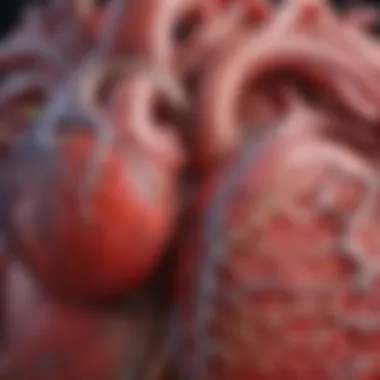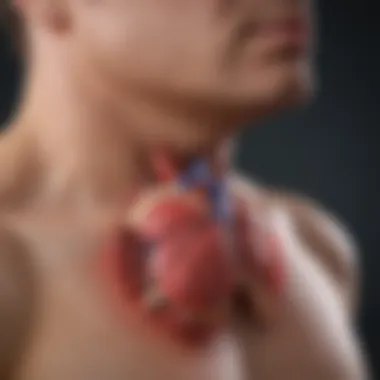Cardiomegaly: Understanding Heart Health Complications


Intro
Cardiomegaly, often misunderstood, is a condition characterized by the enlargement of the heart. This change can denote various underlying issues, reflecting a spectrum of potential cardiac health challenges. Recognizing its implications is essential for healthcare professionals, students, and researchers alike. The growing prevalence of heart diseases warrants a deeper dive into cardiomegaly, its causes, and consequences.
The condition can emerge from numerous factors including hypertension, heart valve diseases, or genetic components. When examining cardiomegaly, it is vital to understand the relationship between this condition and overall cardiac function. This comprehensive exploration aims to elucidate the intricacies surrounding cardiomegaly, enhance awareness of its management, and highlight the necessity for timely intervention.
The complexity of cardiomegaly goes beyond mere enlargement; it signifies various degrees of risk for serious heart conditions. Timely and accurate diagnosis contributes significantly to optimal health outcomes. In the subsequent sections, we will discuss methodologies in research, explore future directions in investigations, and analyze the management strategies available. This information provides a clearer understanding for those involved in healthcare, from students pursuing their qualifications to seasoned professionals engaged in practical applications.
Understanding Cardiomegaly
Understanding cardiomegaly is crucial in the context of overall cardiac health. The condition, characterized by an enlarged heart, can be indicative of underlying health issues. Awareness of its implications, causes, and management strategies enhances the ability of healthcare professionals to diagnose and treat related conditions effectively. This section aims to present core concepts about cardiomegaly, helping both professionals and students understand its relevance in cardiac health discussions.
Definition and Overview
Cardiomegaly refers to an abnormal enlargement of the heart. This condition is not a standalone diagnosis, but rather a sign that often accompanies other heart-related issues. The heart may enlarge as a response to various factors, including high blood pressure, heart valve disease, or cardiomyopathy. This enlargement can potentially impede the heart's ability to pump blood efficiently, leading to complications such as heart failure.
The condition may be detected through imaging tests such as X-rays or echocardiograms. It's essential to differentiate cardiomegaly from healthy heart enlargement due to athletic training, as athletes’ hearts may adapt without leading to any health problems. Typically, cardiomegaly is classified into two types: concentric and eccentric enlargement. Concentric enlargement generally indicates pressure overload, while eccentric enlargement is often due to volume overload.
Historical Context
The study of cardiomegaly has evolved over the years. Initially, heart conditions were often mysterious and poorly understood. In the early medical literature, physicians documented enlarged hearts without a strong grasp of the underlying mechanisms or consequences. As diagnostic tools improved throughout the 20th century, understanding of the condition sharpened.
In more recent decades, research on cardiomegaly has expanded significantly. The introduction of advanced imaging technologies has facilitated better diagnosis and understanding of the condition. Moreover, genetic research has shed light on hereditary factors influencing heart enlargement. Historical context allows us to appreciate the complexity of cardiomegaly and the ongoing efforts to optimize both diagnosis and treatment.
"Understanding the historical background of cardiomegaly paves the way for advancements in treatment and management strategies."
The Cardiac System: An Overview
Understanding the cardiac system is essential in discussing cardiomegaly. The heart functions as the central hub of the circulatory system. Its health directly influences overall well-being. This section aims to outline the primary functions of the heart and its anatomy. By grasping these elements, readers will better appreciate how cardiomegaly affects cardiac health.
Primary Functions of the Heart
The heart’s functions are diverse and critical for life. Here are some key roles:
- Pumping Blood: The heart pumps oxygen-rich blood to the body while receiving oxygen-poor blood. This process sustains cellular function and energy production.
- Regulating Blood Pressure: Through its pumping action, the heart helps maintain blood pressure, ensuring adequate perfusion to vital organs.
- Hormone Distribution: The heart also plays a role in hormone transport, supporting various physiological processes, including metabolism and stress responses.
Each of these functions is vital. A compromised heart cannot perform effectively, leading to health issues like cardiomegaly.
Cardiac Anatomy and Physiology
The anatomy of the heart is intricate. It consists of four chambers: two atria and two ventricles. Their structure is paramount for effective functioning.
- The atria are the upper chambers, responsible for receiving blood. The ventricles are the lower chambers, which pump blood to the lungs and the body.
- Valves regulate blood flow between these chambers. They ensure unidirectional blood flow, preventing backflow.
- The heart muscle or myocardium is crucial for contraction. A thickened myocardium, often seen in cardiomegaly, can significantly impair heart function.
Understanding cardiac anatomy is indispensable in identifying how conditions like cardiomegaly disrupt normal physiology. A thorough comprehension of these structures leads to insights into diagnosis and treatment options.
"The more knowledge healthcare providers have about the heart's functions and design, the better they can address issues like cardiomegaly."
This overview sets the foundational knowledge needed to explore cardiomegaly and its implications further.
Link Between Cardiomegaly and Cardiac Health
Understanding the link between cardiomegaly and overall cardiac health is crucial. Cardiomegaly, which indicates an enlarged heart, often serves as a warning sign of underlying health issues. Recognizing this condition can lead to timely interventions, potentially preventing serious outcomes. It is essential for healthcare professionals to recognize the implications of cardiomegaly in the broader context of heart disease. This section explores how the enlargement of the heart relates to various cardiac conditions, offering insights into the implications for patient management.
Cardiomegaly as a Symptom
Cardiomegaly is not a disease itself but a symptom of various underlying conditions. It arises from a variety of sources, including hypertension, heart valve diseases, and cardiomyopathies. Each of these causes contributes to the heart's enlargement in unique ways. For instance, high blood pressure increases the workload on the heart, leading to its enlargement as it compensates for the increased effort.
Diagnosing cardiomegaly involves recognizing clinical signs during a physical examination, often confirmed through imaging techniques like echocardiograms. Patients may not present with obvious symptoms initially. However, once detected, cardiomegaly can indicate deteriorating cardiac function. Physicians must evaluate the context of cardiomegaly closely, assessing both symptoms presented by the patient and potential comorbidities that may contribute to the enlarged heart.


Comparing Cardiomegaly and Other Cardiac Conditions
Cardiomegaly frequently coexists with other cardiac conditions, complicating diagnosis and treatment. Conditions like congestive heart failure, coronary artery disease, and arrhythmias may coexist with cardiomegaly. Each affects cardiac function differently, necessitating a comprehensive evaluation.
When comparing cardiomegaly to other cardiac issues, several factors come into play:
- Heart Failure: Often presents itself as an enlarged heart, but the causes can differ significantly. While heart failure can cause cardiomegaly, cardiomegaly can also be present without heart failure.
- Coronary Artery Disease: This condition involves blockages in the heart's arteries, leading to reduced blood flow. This can trigger heart muscle enlargement as a maladaptive response.
- Valvular Heart Disease: Diseases affecting heart valves can also lead to structural changes in the heart, including enlargement.
Understanding these relationships is vital for tailoring effective management plans. A clinician's ability to discern whether cardiomegaly is a primary concern or a secondary effect of other cardiac issues can inform treatment strategy.
"Cardiomegaly can serve as a critical indicator of underlying heart health concerns. Recognizing this relationship allows for better patient outcomes through proactive management."
Healthcare providers must approach the diagnosis of cardiomegaly with a comprehensive perspective. Prioritizing awareness about the connections between this condition and more common cardiac diagnoses leads to improved patient care.
Causes of Cardiomegaly
Understanding the causes of cardiomegaly is essential to grasp the broader implications of this heart condition. Cardiomegaly, or an enlarged heart, can signify various underlying health issues. It is vital to recognize that the causes often intertwine with individual lifestyle choices and genetic predispositions. This section offers a detailed exploration of the primary causes of cardiomegaly, enlightening readers about how these factors contribute to heart health degradation.
Hypertension and Heart Disease
Hypertension, or high blood pressure, is one of the most significant contributors to cardiomegaly. The heart is a muscular organ that must work harder to pump blood against elevated pressure in the arteries. Over time, this increased workload can lead to structural changes in the heart, resulting in an enlargement.
Heart disease itself encompasses several conditions that can lead to cardiomegaly. For instance, conditions like coronary artery disease restrict blood flow to the heart, potentially causing ischemia. This can lead to myocardial hypertrophy, a thickening of the heart muscle, which is a common response to chronic stress. According to studies, about 70% of patients diagnosed with cardiomegaly often report a history of hypertension or related cardiovascular diseases.
Genetic Factors
Genetic predisposition plays a critical role in an individual’s likelihood of developing cardiomegaly. Certain inherited conditions, such as familial cardiomyopathy, directly influence heart size and function. These genetic disorders may lead to dysfunction in the heart muscle cells, exacerbating the risk of enlargement.
Moreover, familial patterns of heart disease show a correlation with cardiomegaly. Individuals with close relatives affected by cardiomyopathy or heart failure have a heightened risk. Research highlights how genetic screening can be an effective tool for early detection, facilitating proactive management strategies that can help mitigate future risks.
Lifestyle Impacts
Lifestyle choices significantly impact cardiovascular health and, by extension, the development of cardiomegaly. Factors like diet, physical inactivity, and smoking habits can contribute to the onset of other risk factors, such as obesity and hypertension.
A diet high in sodium, saturated fats, and processed sugars can elevate blood pressure and lead to cardiovascular complications. Conversely, an active lifestyle focused on cardiovascular fitness can reduce these risks. For instance, consistent aerobic exercise strengthens the heart muscle, allowing for more efficient blood flow and reducing the strain on the heart.
Moreover, smoking introduces harmful substances into the bloodstream, increasing the likelihood of arterial plaque buildup. This process can restrict blood flow to the heart, intensifying the risk of cardiomegaly.
In summary, the causes of cardiomegaly are multi-faceted, involving a combination of hypertension, genetic factors, and lifestyle influences. Understanding these elements can enable individuals and healthcare professionals to develop targeted intervention strategies.
By examining these primary causes, it becomes clear that addressing them proactively can significantly affect heart health outcomes.
Symptoms Associated with Cardiomegaly
Understanding symptoms associated with cardiomegaly is critical for identifying and managing this condition. Recognizing these symptoms enables timely intervention and can significantly affect patient outcomes. Symptoms often correlate with the severity and underlying cause of cardiomegaly, making their identification vital for tailored therapeutic strategies.
Physical Signs and Indicators
Patients with cardiomegaly may exhibit various physical signs that are indicative of heart enlargement. Some of the most common physical indicators include:
- Shortness of Breath: Often experienced during physical exertion due to the heart's reduced efficiency in pumping blood.
- Fatigue: Commonly reported by patients, as the heart struggles to meet the body's demand for oxygen-rich blood.
- Swelling in the Legs and Ankles: This may indicate fluid retention, a direct result of the heart’s inability to effectively circulate blood.
- Heart Palpitations: Patients may feel irregular heartbeats, signaling arrhythmias that come with cardiomegaly.
- Chest Pain or Discomfort: A serious symptom that requires immediate attention, as it might indicate related complications.
Recognizing these physical signs is crucial for healthcare providers. They can signal the presence of cardiomegaly and help guide the diagnostic process.
Patient Experience
The experience of patients diagnosed with cardiomegaly can be quite varied. While some may have mild or no symptoms, others may experience significant challenges in daily life.
Patients often report:
- Anxiety and Stress: The diagnosis can lead to feelings of unease about health and longevity.
- Limitations in Activity: Due to symptoms like shortness of breath, individuals may find themselves restricted in physical activities they once enjoyed.
- Seeking Support: Many engage with support groups or forums, such as those found on reddit.com, to connect with others facing similar challenges. This can provide emotional relief and practical coping strategies.


"Understanding the symptoms is a critical step in managing cardiomegaly effectively."
The overall patient experience highlights the importance of monitoring symptoms closely. Proper reporting and management can enhance their quality of life and reduce potential complications. The emphasis on awareness and proactive care can lead to better outcomes for those living with this condition.
Diagnosing Cardiomegaly
Diagnosing cardiomegaly is crucial for understanding heart health and determining appropriate treatment. Early detection can significantly impact patient outcomes and overall quality of life. Cardiomegaly, or an enlarged heart, may be a symptom of underlying conditions. Depending on the cause, available treatment options can vary substantially. Therefore, accurate diagnosis is essential.
A correct diagnosis involves multiple approaches, including diagnostic imaging techniques and laboratory tests. These methods work hand in hand to provide a comprehensive picture of the patient’s cardiac health.
Diagnostic Imaging Techniques
Diagnostic imaging plays a vital role in understanding cardiomegaly. A few common methods include:
- Echocardiogram: This ultrasound of the heart is often the first test done. It shows heart size and function in real-time, helping to identify structural abnormalities.
- Chest X-ray: A simple X-ray can reveal enlarged heart size compared to the surrounding structures. It’s quick and widely available.
- Cardiac MRI: This provides detailed images of the heart's structure and function. MRI is particularly useful for certain types of cardiomyopathy that may not be easily identified by other imaging.
These techniques can help differentiate between cardiomyopathy types and highlight their potential causes. For example, certain images may indicate fluid buildup or muscle thickening, directing clinicians towards specific diagnoses.
"Accurate imaging is key for effective management of cardiomegaly, guiding treatment decisions, and improving outcomes."
Laboratory Tests
While imaging techniques provide visual insight, laboratory tests offer biochemical perspectives. Common tests include:
- Blood Tests: These evaluate levels of biomarkers like B-type natriuretic peptide (BNP). Elevated BNP levels often correlate with heart failure and can indicate cardiomegaly.
- Electrolyte Panels: Checking sodium, potassium, and other electrolyte levels helps assess overall health and identify issues that may contribute to cardiovascular strain.
- Thyroid Function Tests: Since thyroid disorders can affect heart size and function, these tests are relevant for understanding possible hormonal influences on cardiomegaly.
Comprehensive lab work combined with imaging techniques leads to better decision-making for clinicians. As findings emerge, it becomes more possible to tailor treatments to the individual patient.
By understanding how cardiomegaly is diagnosed, patients and healthcare professionals alike can engage in informed discussion about the potential risks and management strategies. Both imaging techniques and laboratory tests are indispensable in this pursuit.
Management and Treatment Options
Management and treatment of cardiomegaly are crucial elements in maintaining cardiac health. The number of individuals diagnosed with this condition is increasing, emphasizing the need for effective strategies. Proper management not only improves outcomes but also enhances the quality of life for patients. It is essential to consider multiple factors when deciding on a treatment course, including the underlying causes, the severity of the condition, and the overall health status of the individual. This section explores pharmacological treatments, lifestyle modifications, and surgical interventions as key components of management.
Pharmacological Treatments
Pharmacological treatments for cardiomegaly primarily target the underlying causes such as hypertension and heart failure. Common medications include ACE inhibitors, beta-blockers, and diuretics. Each of these plays a distinct role:
- ACE Inhibitors: Help relax blood vessels, which reduces workload on the heart.
- Beta-blockers: Lower heart rate and blood pressure, thereby reducing cardiac stress.
- Diuretics: Assist in removing excess fluid from the body, which is important for individuals experiencing fluid retention.
These pharmacological options are often used in combination to maximize efficacy. Adjustments in medication doses are made based on regular monitoring, which is critical to avoid potential side effects and ensure the patient's safety. Regular consultations with healthcare providers are key to finding the right medication regimen.
Lifestyle Modifications
Lifestyle modifications represent a non-pharmacological aspect of managing cardiomegaly. People diagnosed with this condition should consider various changes that can impact their overall cardiovascular health positively. Effective lifestyle changes include:
- Diet: A heart-healthy diet, low in sodium and saturated fats, is essential. Foods rich in omega-3 fatty acids, fruits, and vegetables should be incorporated.
- Exercise: Regular physical activity enhances cardiovascular function. Endurance exercises like walking, cycling, or swimming are often advised, depending on the individual's capacity.
- Weight Management: Achieving and maintaining a healthy weight is crucial for reducing the burden on the heart.
Behavioral modifications can also include quitting smoking and reducing alcohol intake. These factors not only help in managing cardiomegaly but also improve overall health.
Surgical Interventions
Surgical interventions may become necessary in severe cases of cardiomegaly, especially when treatments have not led to sufficient improvement. Surgical options can be diverse:
- Coronary Bypass Surgery: In patients with blockages, this procedure helps restore blood flow to the heart.
- Valve Repair or Replacement: Dysfunction in heart valves may require surgical correction to improve heart function.
- Implantable Cardioverter-Defibrillators (ICDs): These devices monitor heart rhythms and can deliver electrical shocks to correct life-threatening arrhythmias.
Each surgical option comes with its risks and benefits. Assessment by a multidisciplinary team is important to determine the most appropriate course of action. Overall, surgical interventions can significantly enhance outcomes when other management options fail.
Advancements in technology and treatment methodologies continue to evolve, which further enhances the potential for successful management of cardiomegaly.


Prognosis and Long-term Outcomes
Understanding the prognosis and long-term outcomes of cardiomegaly is critical in the management of this condition. It informs both patients and healthcare providers about what to expect over time and how to navigate the complexities of cardiac health. Prognosis involves evaluating multiple factors, such as the underlying causes of cardiomegaly, the patient's overall health, and lifestyle behaviors, as these elements strongly influence the eventual outcomes.
Potential Complications
When cardiomegaly is present, various complications may arise, underscoring the necessity for ongoing monitoring and intervention. Some notable potential complications include:
- Heart Failure: The heart's ability to pump blood may diminish over time.
- Arrhythmias: Irregular heartbeats can occur, leading to further health risks.
- Thromboembolic Events: Increased risk of blood clots can lead to strokes or pulmonary embolism.
- Cardiovascular Events: Conditions such as myocardial infarction may become more likely.
These complications necessitate regular evaluations and potentially aggressive management strategies. Recognizing these risks early can allow for timely interventions, improving overall patient outcomes.
Improving Cardiovascular Health
Enhancing cardiovascular health plays a crucial role in the prognosis of individuals with cardiomegaly. Here are several approaches that can positively impact long-term outcomes:
- Regular Medical Follow-ups: Consistent check-ups with healthcare providers are essential to monitor heart health and adjust treatment plans as necessary.
- Lifestyle Changes: Adopting a heart-healthy lifestyle can significantly improve outcomes. This includes:
- Medication Adherence: Following prescribed pharmacological treatments is vital. This often includes medications to manage blood pressure, cholesterol levels, or arrhythmias.
- Education and Awareness: Patients should be informed about their condition, which promotes active participation in their health management.
- Maintaining a balanced diet rich in fruits, vegetables, and whole grains.
- Engaging in regular physical activity tailored to the individual's capabilities.
- Managing stress through mindfulness or suitable relaxation techniques.
Improving cardiovascular health is not just about treating the condition itself but enhancing the entire quality of life for the patient.
Ultimately, a proactive approach to managing cardiomegaly can lead to improved prognosis and better long-term outcomes. Individuals diagnosed with this condition should work closely with healthcare professionals to develop a comprehensive plan addressing all aspects of heart health.
Future Directions in Cardiomyopathy Research
Research in cardiomyopathy is crucial due to its complex nature and its impact on heart health and overall well-being. Understanding future directions in this field can shed light on innovative interventions and potential breakthroughs. As the healthcare landscape evolves, there is a pressing need for a deeper comprehension of the underlying mechanisms of cardiac conditions like cardiomegaly. This section explores emerging technologies and genomic insights that hold promise for enhancing diagnosis and treatment options.
Emerging Technologies
Advancements in technology are rapidly transforming the approach to cardiomyopathy research. These developments enable more precise diagnostics and tailored treatments. Some key technologies include:
- Wearable Devices: These tools track heart rate, rhythm, and other vital signs. They help patients monitor their cardiac health in real time.
- Telemedicine: Remote consultations provide accessible care for patients with cardiomyopathy, crucial for continuity in management.
- Artificial Intelligence (AI): AI offers enhanced predictive analytics for identifying at-risk patients and personalizing treatment protocols based on individual cases.
By employing these technologies, researchers and healthcare professionals can gain deeper insights into the progression of cardiomyopathy, which is essential for improving patient outcomes.
Genomic Insights
The role of genomics in cardiomyopathy research cannot be overstated. As genomic technologies advance, the potential to uncover genetic predispositions to cardiomyopathy grows. Important aspects include:
- Genetic Testing: Identifying mutations linked to cardiomyopathy facilitates earlier diagnoses and targeted therapies.
- Understanding Gene Expression: Researchers explore how variations in gene expression can affect heart function and contribute to cardiomegaly.
- Personalized Medicine: Insights from genomics enable the customization of treatment plans, improving effectiveness and minimizing adverse effects.
By focusing on genomic research, the field strives to better understand the hereditary nature of cardiomyopathy and develop more effective, individualized therapies.
"The future of cardiomyopathy research lies at the nexus of technology and genetics, promising a more profound impact on patient care and treatment outcomes."
In summary, future directions in cardiomyopathy research emphasize the integration of emerging technologies and genomic insights. These advancements present significant opportunities to enhance the understanding and management of cardiomyopathy, ultimately contributing to improved cardiac health on a broader scale.
End
The conclusion serves a pivotal role in summarizing the diverse aspects of cardiomegaly and its impact on cardiac health. It encapsulates the main points discussed throughout the article, reinforcing the significance of understanding this medical condition. A clear presentation of facts is crucial for those studying cardiology or related fields, as it allows for a synthesis of knowledge that can be applied in both clinical and research settings.
Recapitulation of Key Points
In revisiting the critical themes, we recognize the following points as fundamental:
- Definition of Cardiomegaly: The enlargement of the heart muscle, often as a response to various stressors or underlying conditions.
- Causes: Include hypertension, genetic predispositions, and lifestyle choices.
- Symptoms: While some patients may remain asymptomatic, others can experience fatigue, shortness of breath, and arrhythmias.
- Diagnosis: Utilization of imaging techniques such as echocardiograms and diagnostic tests to confirm the condition.
- Management: Involves pharmacological treatments, lifestyle changes, and possibly surgical interventions when necessary.
- Future Research: Focuses on emerging technologies and genomic insights that aim to improve understanding and treatment of cardiomegaly.
These points, when well understood, can enhance awareness of cardiac health implications associated with cardiomegaly.
The Importance of Awareness
Raising awareness about cardiomegaly is crucial for several reasons:
- Timely Intervention: Greater awareness can lead to earlier diagnoses, allowing for prompt treatment and management.
- Outcome Improvement: Informing patients and healthcare providers about the risks associated with untreated cardiomegaly can contribute to better health outcomes.
- Education: Knowledge dissemination regarding lifestyle choices and risk factors is essential in preventing the onset of cardiomegaly.
- Community Engagement: Awareness programs can foster community support networks, facilitating shared resources and knowledge on heart health.
In summary, the final thoughts prompt us to recognize the essential role of awareness in combating global health challenges posed by conditions like cardiomegaly. Only with a deeper understanding of these health issues can individuals take proactive steps towards improved cardiac wellbeing.







